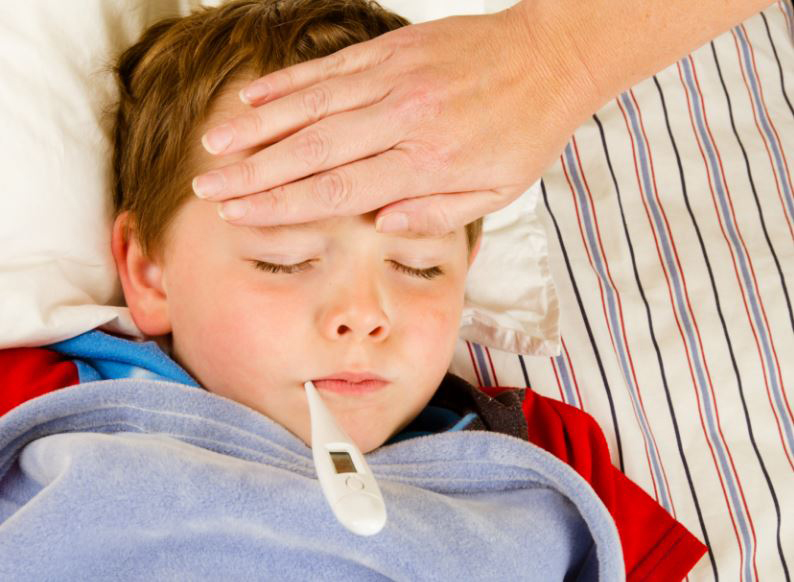MI-EL TAKES CARE OF YOUR HEALTH – FEVER
The body’s normal temperature is 37 °C (98.6 ° F), although it can vary slightly throughout the day. If your child’s temperature is higher than normal, it indicates that he or she has a fever.
Fever is not a disease in itself. It is usually a sign that the body is fighting an infection. When a germ activates the body’s defenses (immune system), there are many reactions that occur. Fever is a sign of those reactions.
How can I measure body temperature?
Children feel warm to the touch. To confirm that your child has a fever, use a thermometer and measure their body temperature.
There are several methods to measure temperature in children:
1-Oral temperature.
Introduce the thermometer under the tongue for two minutes, if it is higher than 37. 5 ° C it means they have a fever. It can be used on older children.
2-Rectal temperature.
It is the most accurate temperature; it is inserting the thermometer in the anus. If it is higher than 38 ° C, we can say that the child has a fever.
3-Axillary temperature.
It is the least accurate method, although it can be used by adding 2 °C to the measured temperature. It is done by placing the thermometer under the armpit for two minutes. If it is higher than 37.2 ° C it is considered a fever.
4-Tympanic temperature.
It is the least used; it is measured by placing the thermometer in the ear. Greater than 38 ° C, is considered a fever.
5-Digital.Nowadays, electronic devices are often used.
Placing the thermometer close to the forehead or ear gives a value. It is considered fever if it is greater than 37.2 ° C
What causes fever?
Infections can cause fever. It is necessary to observe the signs and symptoms that the child is presenting in addition to the fever. The temperature presented also gives light to pediatricians, to diagnose if the infectious process is mild or acute, viral or bacterial.
Fever by itself can occur by extreme physical activity, knocks or bruises, or wearing too many layers in hot weather. Vaccines also often cause fever.
MI-EL CUIDA TU SALUD – LA FIEBRE
La temperatura normal del cuerpo es de 37 °C (98,6 °F), aunque puede variar ligeramente a lo largo del día. Si la temperatura de su niño es más alta que lo normal, indica que tiene fiebre.
La fiebre no es una enfermedad en sí misma. Generalmente es un signo de que el organismo está luchando contra una infección. Cuando un germen activa las defensas del organismo (sistema inmunológico), son muchas las reacciones que ocurren, y la fiebre es un signo de esas reacciones.
¿Cómo puedo medir la temperatura corporal?
Los niños se sienten calientes al tacto. Para confirmar que su niño tiene fiebre, utilice un termómetro y mida su temperatura corporal.
Hay varios métodos de tomar la temperatura en los niños:
1-Temperatura oral.
Es introduciendo el termómetro debajo de la lengua por dos minutos, si está mayor de 37. 5 °C significa que tiene fiebre. Se les puede realizar a los niños mayores.
2-Temperatura rectal.
Es la temperatura más precisa, es insertando el termómetro en el ano. Si está mayor de 38°C podemos decir que el niño tiene fiebre.
3Temperatura axilar.
Es la menos precisa, colocando el termómetro debajo de la axila por dos minutos, aunque la podemos utilizar, agregándole dos centígrados. Mayor de 37.2 °C se considera fiebre.
4-Temperatura Timpánica.
Es la menos usada, se mide colocando el termómetro en el oído. Mayor de 38°C, se considera fiebre.
5-Digital.
Hoy en día se está utilizando a menudo los aparatos electrónicos. Colocando el termómetro próximo a la frente o al oído da un valor. Se considera fiebre mayor de 37.2°C
¿Qué causa la fiebre?
Las infecciones, pueden causar fiebre. Es necesario observar los signos y los síntomas que está presentando el niño además de la fiebre. Los grados que presente también le dan luz a los pediatras, para diagnosticar si el proceso infeccioso es leve o agudo, si es viral o bacteriana.
La fiebre por si sola puede ocurrir por esfuerzo físico, por golpes, cuando se permanece por mucho tiempo abrigado, o cuando hace calor. Las vacunas también suelen producir fiebre.






